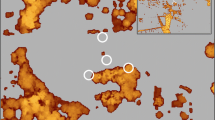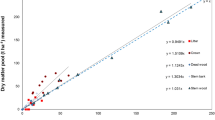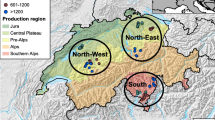Abstract
Site index is an important forest inventory attribute that relates productivity and growth expectation of forests over time. In forest inventory programs, site index is used in conjunction with other forest inventory attributes (i.e., height, age) for the estimation of stand volume. In turn, stand volumes are used to estimate biomass (and biomass components) and enable conversion to carbon. In this research, we explore the implications and consequences of different estimates of site index on carbon stock characterization for a 2,500-ha Douglas-fir-dominated landscape located on Eastern Vancouver Island, British Columbia, Canada. We compared site index estimates from an existing forest inventory to estimates generated from a combination of forest inventory and light detection and ranging (LIDAR)-derived attributes and then examined the resultant differences in biomass estimates generated from a carbon budget model (Carbon Budget Model of the Canadian Forest Sector (CBM-CFS3)). Significant differences were found between the original and LIDAR-derived site indices for all species types and for the resulting 5-m site classes (p < 0.001). The LIDAR-derived site class was greater than the original site class for 42% of stands; however, 77% of stands were within ±1 site class of the original class. Differences in biomass estimates between the model scenarios were significant for both total stand biomass and biomass per hectare (p < 0.001); differences for Douglas-fir-dominated stands (representing 85% of all stands) were not significant (p = 0.288). Overall, the relationship between the two biomass estimates was strong (R 2 = 0.92, p < 0.001), suggesting that in certain circumstances, LIDAR may have a role to play in site index estimation and biomass mapping.
Similar content being viewed by others
References
Aalde, H., Gonzalez, P. M., Gytarsky, T., Krug, W. A., Kurz, S., Ogle, J., et al. (2006). Forest land. In H. S. Eggleston, L. Buendia, K. Miwa, T. Ngara & K. Tanabe (Eds.), 2006 IPCC guidelines for national greenhouse gas inventories (pp 4.1–4.83). Hayama, Japan: IPCC National Greenhouse Gas Inventories Programme, Institute for Global Environmental Strategies.
Avery, T. E., & Burkhart, H. E. (2002). Forest measurements (480 pp.). New York: McGraw-Hill.
Axelsson, P. (1999). Processing of laser scanner data–algorithms and applications. ISPRS Journal of Photogrammetry and Remote Sensing, 54, 138–147. doi:10.1016/S0924-2716(99)00008-8.
Baldocchi, D. D. (2003). Assessing the eddy covariance technique for evaluating carbon dioxide exchange rates of ecosystems: Past, present, and future. Global Change Biology, 9, 479–492. doi:10.1046/j.1365-2486.2003.00629.x.
Boudewyn, P., Song, X., Magnussen, S., & Gillis, M. D. (2007). Model-based, volume-to-biomass conversion for forested and vegetated land in Canada. (124 pp.) Information Report BC-X-411, Natural Resources Canada, Canadian Forest Service, Pacific Forestry Centre, Victoria, British Columbia.
Boyer, W. D. (2001). A generational change in site index for naturally established longleaf pine on a south Alabama coastal plain site. Southern Journal of Applied Forestry, 25, 88–92.
British Columbia Ministry of Environment, Lands, and Parks (1992). British Columbia specifications and guidelines for geomatics. content series volume 3: Digital baseline mapping at 1:20 000, Release 2.0. Ministry of Environment, Lands, and Parks, Victoria, British Columbia, Canada. http://ilmbwww.gov.bc.ca/bmgs/pba/trim/specs/specs20.pdf. Accessed 24 July 2008.
British Columbia Ministry of Forests (1996). Variable density yield prediction (VDYP) batch application user guide. Version 6.3. (18 pp.). Victoria, British Columbia: Resources Inventory Branch.
British Columbia Ministry of Forests (1999). How to determine site index in silviculture? Participant’s workbook. Forest Practices Branch, Victoria, British Columbia. http://www.for.gov.bc.ca/hfp/training/00011/acrobat/sicourse.pdf. Accessed 24 July 2008.
British Columbia Ministry of Forests and Range (2004). SiteTools. Research Branch, Victoria, British Columbia http://www.for.gov.bc.ca/hre/sitetool/. Accessed 24 July 2008.
Bruce, D. (1981). Consistent height-growth and growth-rate estimates for remeasured plots. Forest Science, 27, 711–725.
Chen, Q., Gong, P., Baldocchi, D. D., & Xie, G. (2007). Filtering airborne laser scanning data with morphological methods. Photogrammetric Engineering and Remote Sensing, 73, 171–181.
Clark, D. A., Brown, S., Kicklighter, D. W., Chambers, J. Q., Thomlinson, J. R., & Ni, J. (2001). Measuring net primary production in forests: Concepts and field methods. Ecological Applications, 11, 356–370. doi:10.1890/1051-0761(2001)011[0356:MNPPIF]2.0.CO;2.
Coops, N. C., Hilker, T., Wulder, M. A., St-Onge, B., Newnham, G., Siggins, A., et al. (2007). Estimating canopy structure of Douglas-fir forest stands from discrete-return LiDAR. Trees (Berlin), 21, 295–310. doi:10.1007/s00468-006-0119-6.
Demarchi, D. A. (1996). An introduction to the ecoregions of British Columbia. British Columbia Ministry of Environment, Lands and Parks, Victoria, British Columbia. http://www.llbc.leg.bc.ca/public/PubDocs/bcdocs/325282/techpub_rn324.pdf. Accessed 24 July 2008.
Denman, K. L., Brasseur, G., Chidthaisong, A., Ciais, P., Cox, P. M., Dickinson, R. E., et al. (2007). Couplings between changes in the climate system and biogeochemistry. In S. Solomon, D. Qin, M. Manning, Z. Chen, M. Marquis, K. B. Averyt, M. Tignor & H. L. Miller (Eds.), Climate change 2007: The physical science basis. Contribution of working group I to the fourth assessment report of the intergovernmental panel on climate change (996 pp.). Cambridge: Cambridge University Press.
Dubayah, R., & Drake, J. B. (2000). Lidar remote sensing for forestry. Journal of Forestry, 98, 44–46.
Forest Productivity Council of British Columbia (1998a). Definition and estimation of top height for site index. Technical Advisory Committee. http://www.for.gov.bc.ca/hre/fpc/standards/topheight/index.htm. Accessed 24 July 2008.
Forest Productivity Council of British Columbia (1998b). Top height definition. Technical Advisory Committee. http://www.for.gov.bc.ca/hre/fpc/standards/topheight/top_height.htm. Accessed 24 July 2008.
García, O., & Batho, A. (2005). Top height estimation in lodgepole pine sample plots. Western Journal of Applied Forestry, 20, 64–68.
Gatziolis, D. (2007). LIDAR-derived site index in the U.S. pacific northwest–challenges and opportunities. In Proceedings of the ISPRS workshop on laser scanning 2007 and SilviLaser 2007, September 12–14 2007, IAPRS Volume XXXVI, Part 3, W52, 2007, (pp. 137–143). Espoo: Finland.
Gillis, M. D., & Leckie, D. (1996). Forest inventory update in Canada. Forestry Chronicle, 72, 138–156.
Gillis, M. D., Omule, A. Y., & Brierly, T. (2005). Monitoring Canada’s forests: The national forest inventory. Forestry Chronicle, 81, 214–221.
Green, R. N., & Klinka, K. (1994). A field guide to site identification and interpretation for the Vancouver forest region: Land management handbook #28. Ministry of Forests, Research Branch, Victoria, British Columbia. http://www.for.gov.bc.ca/hfd/pubs/docs/Lmh/Lmh28.pdf. Accessed 24 July 2008.
Hägglund, B. (1981). Evaluation of forest site productivity. Forestry Abstracts, 42, 515–527.
Hall, R. J. (2003). The roles of aerial photographs in forestry remote sensing image analysis. In M. A. Wulder & S. E. Franklin (Eds.), Remote sensing of forest environments: Concepts and case studies (pp. 47–77). Boston: Kluwer.
Hamilton, J. G., DeLucia, E. H., George, K., Naidu, S. L., Finzi, A. C., & Schlesinger, W. H. (2002). Forest carbon balance under elevated CO2. Oecologia, 131, 250–260. doi:10.1007/s00442-002-0884-x.
Hasenauer, H., & Monserud, R. A. (1997). Biased predictions for tree height increment models developed from smoothed ‘data’. Ecological Modelling, 98, 13–22. doi:10.1016/S0304-3800(96)01933-3.
Heo, J., Park, J. S., Song, Y., Lee, S. K., & Sohn, H. (2008). An integrated methodology for estimation of forest fire-loss using geospatial information. Environmental Monitoring and Assessment, 144, 285–299. doi:10.1007/s10661-007-9992-8.
Huang, S., Monserud, R. A., Braun, T., Lougheed, H., & Bakowsky, O. (2004). Comparing site productivity of mature fire-origin and post-harvest juvenile lodgepole pine stands in Alberta. Canadian Journal of Forest Research, 34, 1181–1191. doi:10.1139/x04-009.
Humphreys, E. R., Black, T. A., Morgenstern, K., Cai, T., Drewitt, G., Nesic, Z., et al. (2006). Carbon dioxide fluxes in coastal Douglas-fir stands at different stages of development after clearcut harvesting. Agriculture and Forest Meterology, 140, 6–22. doi:10.1016/j.agrformet.2006.03.018.
Jungen, J. R. (1985). Soils of southern Vancouver island. British Columbia soil survey report 44. Ministry of environment technical report 17, 198 pp. British Columbia Ministry of Environment, Victoria, British Columbia. http://sis.agr.gc.ca/cansis/publications/bc/bc44/bc44_report.pdf. Accessed 24 July 2008.
Kangas, A., Gove, J. H., & Scott, C. T. (2006). Introduction. In A. Kangas & M. Maltamo (Eds.), Forest inventory: methodology and applications (pp. 3–8). Dordrecht, Netherlands: Springer.
Kraus, K., & Pfeiffer, N. (1998). Determination of terrain models in wooded areas with airborne laser scanner data. ISPRS Journal of Photogrammetry and Remote Sensing, 54, 193–203. doi:10.1016/S0924-2716(98)00009-4.
Kull, S., Kurz, W. A., Rampley, G., Banfield, G. E., Schivatcheva, R. K., Apps, M. J. (2006). Operational-scale carbon budget model of the Canadian forest sector (CBM-CFS3) version 1.0 (320 pp.). Edmonton, Alberta: Natural Resources Canada, Canadian Forest Service, Northern Forestry Centre.
Kurz, W. A., & Apps, M. J. (1999). A 70-year retrospective analysis of carbon fluxes in the Canadian forest sector. Ecological Applications, 9, 526–547. doi:10.1890/1051-0761(1999)009[0526:AYRAOC]2.0.CO;2.
Kurz, W. A., Apps, M. J., Banfield, E., & Stinson, G. (2002). Forest carbon accounting at the operational scale. Forestry Chronicle, 78, 672–679.
Kurz, W. A., Apps, M. J., Webb, T. M., & McNamee, P. J. (1992). The carbon budget of the Canadian Forest Sector: Phase I. Information Report NOR-X-326, Edmonton, Alberta: Forestry Canada, Northwest Rregion, Northern Forestry Centre.
Lal, R., Kimble, J. M., Follett, R. F., & Stewart, B. A. (2001). Assessment methods for soil carbon (advances in soil science) (696 pp.). Boca Raton, Florida: Lewis Press.
Landsberg, J. (2003). Modelling forest ecosystems: State of the art, challenges, and future directions. Canadian Journal of Forest Research, 33, 385–397. doi:10.1139/x02-129.
Lefsky, M., Turner, D., Guzy, M., & Cohen, W. (2005). Combining lidar estimates of aboveground biomass and landsat estimates of stand age for spatially extensive validation of modeled forest productivity. Remote Sensing of Environment, 95, 549–558. doi:10.1016/j.rse.2004.12.022.
Li, Z., Kurz, W. A., Apps, M. J., & Beukema, S. J. (2003). Belowground biomass dynamics in the carbon budget model of the Canadian Forest Sector: Recent improvements and implications for the estimation of NPP and NEP. Canadian Journal of Forest Research, 33, 126–136. doi:10.1139/x02–165.
Lim, K., Treitz, P., Wulder, M. A., St-Onge, B., & Flood, M. (2003). LIDAR remote sensing of forest structure. Progress in Physical Geography, 27, 88–106. doi:10.1191/0309133303pp360ra.
Lovell, J. L., Jupp, D. L. B., Newnham, G. J., Coops, N. C., & Culvenor, D. S. (2005). Simulation study for finding optimal LIDAR acquisition parameters for forest height retrieval. Forest Ecology and Management, 214, 398–412. doi:10.1016/j.foreco.2004.07.077.
Magnussen, S. (1999). Effect of plot size on estimtes of top height in Douglas-fir. Western Journal of Applied Forestry, 14, 17–27.
Magnussen, S., & Boudewyn, P. (1998). Derivations of stand heights from airborne laser scanner data with canopy-based quantile estimators. Canadian Journal of Forest Research, 28, 1016–1031. doi:10.1139/cjfr-28-7-1016.
Magnussen, S., Eggermont, P., & LaRiccia, V. (1999). Recovering tree heights from airborne laser scanner data. Forest Science, 45, 407–422.
Mah, S., & Nigh, G. D. (2003). SIBEC site index estimates in support of forest management in British Columbia. Technical report 004. Research Branch, British Columbia Ministry of Forests, Victoria, British Columbia. http://www.for.gov.bc.ca/hfd/pubs/Docs/Tr/Tr004.pdf. Accessed 24 July 2008.
McRoberts, R. E., & Tomppo, E. O. (2007). Remote sensing support of national forest inventories. Remote Sensing of Environment, 110, 412–419. doi:10.1016/j.rse.2006.09.034.
Mitchell, K. J., Stone, M., Grout, S. E., Di Lucca, M., Nigh, G. D., Goudie, J. W., et al. (2000). TIPSY version 3.0. Ministry of Forests, Research Branch, Victoria, British Columbia. http://www.for.gov.bc.ca/hre/gymodels/tipsy/. Accessed 24 July 2008.
Næsset, E. (1997). Determination of mean tree height of forest stands using airborne laser scanner data. ISPRS Journal of Photogrammetry and Remote Sensing, 52, 49–56. doi:10.1016/S0924-2716(97)83000-6.
Næsset, E. (2002). Predicting forest stand characteristics with airborne scanning laser using a practical two-stage procedure and field data. Remote Sensing of Environment, 80, 88–99. doi:10.1016/S0034-4257(01)00290-5.
Næsset, E., & Økland, T. (2002). Estimating tree height and tree crown properties using airborne scanning laser in a boreal nature reserve. Remote Sensing of Environment, 79, 105–115. doi:10.1016/S0034-4257(01)00243-7.
Næsset, E., Bollandsas, O., & Gobakken, T. (2005). Comparing regression methods in estimation of biophysical properties of stands from two different inventories using laser scanner data. Remote Sensing of Environment, 94, 541–553. doi:10.1016/j.rse.2004.11.010.
Nelson, R., Valenti, M., Short, A., & Keller, C. (2003). A multiple resource inventory of Deleware using airborne laser data. Bioscience, 53, 981–992. doi:10.1641/0006-3568(2003)053[0981:AMRIOD]2.0.CO;2.
Nigh, G. D., & Courtin, P. J. (1998). Height models for red alder (Alnus rubra Bong) in British Columbia. New Forests, 16, 59–70. doi:10.1023/A:1006561502635.
Nigh, G. D., & Love, B. (1999). A model for estimating juvenile height of lodgepole pine. Forest Ecology and Management, 123, 157–166. doi:10.1016/S0378-1127(99)00019-5.
Nigh, G. D., & Mitchell, M. G. E. (2003). Development of height–age models for estimating juvenile height of coastal Douglas-fir in British Columbia. Western Journal of Applied Forestry, 18, 207–212.
Ni-Meister, W., Jupp, D. L., & Dubayah, R. (2001). Modeling LIDAR waveforms in heterogeneous and discrete caopies. Geoscience and Remote Sensing, 39, 1943–1957. doi:10.1109/36.951085.
Nussbaum, A. F. (1998). Site index adjustments for old-growth stands based on paired plots. Research Branch, British Columbia Ministry of Forests, Victoria, British Columbia. Working Paper 37. http://www.for.gov.bc.ca/hfd/pubs/docs/Wp/Wp37.pdf. Accessed 24 July 2008.
Persson, A., Holmgren, J., & Soderman, U. (2002). Detecting and measuring individual trees using an airborne laser scanner. Photogrammetric Engineering and Remote Sensing, 68, 925–932.
Pojar, J., Klinka, K., & Demarchi, D. A. (1991). Coastal western Hemlock zone. In D. Meidinger & J. Pojar (Eds.), Ecosystems of British Columbia, BC Special Report Series No. 6 (pp 95–111). Victoria, British Columbia: British Columbia Ministry of Forests.
Popescu, S. C. (2007). Estimating biomass of individual pine trees and tree components using airborne LiDAR. Biomass & Bioenergy, 31, 646–655. doi:10.1016/j.biombioe.2007.06.022.
Popescu, S. C., & Wynne, R. H. (2004). Seeing the trees in the forest: Using lidar and multispectral data fusion with local filtering and variable window size for estimating tree height. Photogrammetric Engineering and Remote Sensing, 70, 589–604.
Popescu, S. C., Wynne, R. H., & Nelson, R. F. (2002). Estimating plot-level tree heights with lidar: Local filtering with a canopy height based variable window size. Computers and Electronics in Agriculture, 37, 71–95. doi:10.1016/S0168-1699(02)00121-7.
Reutebuch, S. E., Andersen, H. E., & McGaughey, R. J. (2005). Light detection and ranging (LIDAR): An emerging tool for multiple resource inventory. Journal of Forestry, 103, 286–292.
Reutebuch, S. E., McGaughey, R. J., Anderson, H. E., & Carson, W. W. (2003). Accuracy of a high-resolution LIDAR terrain model under a conifer forest canopy. Canadian Journal of Remote Sensing, 29, 527–535.
Roggero, M. (2001). Airborne laser scanning: Clustering in raw data. International Archives of the Photogrammetry, Remote Sensing and Spatial Information Sciences, XXXIV-3(W4), 227–232.
Running, S., Baldocchi, D., Turner, D., Gower, S., Bakwin, P., & Hibbard, K. (1999). A global terrestrial monitoring network integrating tower fluxes, flask sampling, ecosystem modeling and EOSD satellite data. Remote Sensing of Environment, 70, 108–127. doi:10.1016/S0034-4257(99)00061-9.
Sharma, M., & Parton, J. (2007). Height-diameter equations for boreal tree species in Ontario using a mixed-effects modeling approach. Forest Ecology and Management, 249, 187–198. doi:10.1016/j.foreco.2007.05.006.
Sithole, G., & Vosselman, G. (2004). Experimental comparison of filter algorithms for bare-Earth extraction from airborne laser scanning point clouds. ISPRS Journal of Photogrammetry and Remote Sensing, 59, 85–101. doi:10.1016/j.isprsjprs.2004.05.004.
Skovsgaard, J. P., & Vanclay, J. K. (2007). Forest site productivity: A review of the evolution of dendrometric concepts for even-aged stands. Forestry, 81, 13–31. doi:10.1093/forestry/cpm041.
Stearns-Smith, S. (2001). Making sense of site index estimates in British Columbia: A quick look at the big picture. BC Journal of Ecosystems and Management, 1, 1–4.
St-Onge, B., Hu, Y., & Vega, C. (2008). Mapping the height and aboveground biomass of mixed forest using lidar and stereo Ikonos images. International Journal of Remote Sensing, 29, 1277–1294. doi:10.1080/01431160701736505.
St-Onge, B., Jumelet, J., Cobello, O., & Vega, C. (2004). Measuring individual tree height using a combination of stereophotogrammetry and lidar. Canadian Journal of Forest Research, 34, 2122–2130. doi:10.1139/x04-093.
St-Onge, B., Treitz, P., & Wulder, M. A. (2003). Tree and canopy height estimation with scanning LIDAR. In M. A. Wulder & S. E. Franklin (Eds.), Remote sensing of forest environments: Concepts and case studies (pp. 489–510). Boston, Massachusettes: Kluwer Academic Publishers.
Trofymow, J. A., Stinson, G., & Kurz, W. (2008). Derivation of a spatially-explicit 86-year retrospective carbon budget for a landscape undergoing conversion from old-growth to managed forests on Vancouver island. Forest Ecology and Management, 256, 1677–1691. http://dx.doi.org/10.1016/j.foreco.2008.02.056.
Véga, C., & St-Onge, B. (2008). Height growth reconstruction of a boreal forest canopy over a period of 58 years using a combination of photogrammetric and lidar models. Remote Sensing of Environment, 112, 1784–1794. doi:10.1016/j.rse.2007.09.002.
Wilson, J. S., & Oliver, C. D. (2000). Stability and density management in Douglas-fir plantations. Canadian Journal of Forest Research, 30, 910–920. doi:10.1139/cjfr-30-6-910.
Wulder, M. A., Kurz, W. A., & Gillis, M. (2004). National level forest monitoring and modeling in Canada. Progress in Planning, 61, 365–381. doi:10.1016/S0305-9006(03)00069-2.
Author information
Authors and Affiliations
Corresponding author
Rights and permissions
About this article
Cite this article
Wulder, M.A., White, J.C., Stinson, G. et al. Implications of differing input data sources and approaches upon forest carbon stock estimation. Environ Monit Assess 166, 543–561 (2010). https://doi.org/10.1007/s10661-009-1022-6
Received:
Accepted:
Published:
Issue Date:
DOI: https://doi.org/10.1007/s10661-009-1022-6




